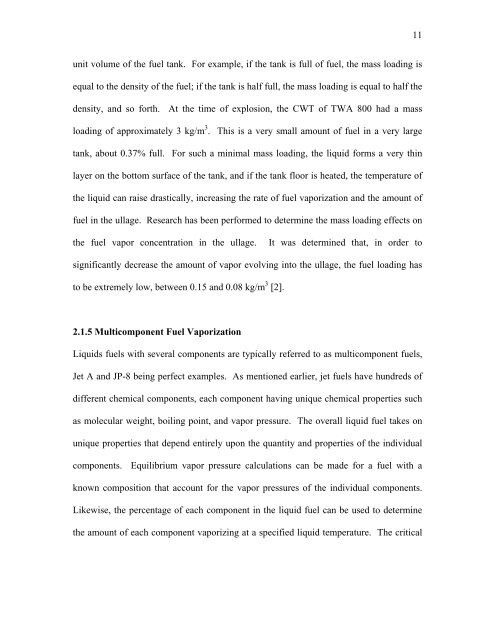Vaporization of JP-8 Jet Fuel in a Simulated Aircraft Fuel Tank ...
Vaporization of JP-8 Jet Fuel in a Simulated Aircraft Fuel Tank ...
Vaporization of JP-8 Jet Fuel in a Simulated Aircraft Fuel Tank ...
Create successful ePaper yourself
Turn your PDF publications into a flip-book with our unique Google optimized e-Paper software.
unit volume <strong>of</strong> the fuel tank. For example, if the tank is full <strong>of</strong> fuel, the mass load<strong>in</strong>g is<br />
equal to the density <strong>of</strong> the fuel; if the tank is half full, the mass load<strong>in</strong>g is equal to half the<br />
density, and so forth. At the time <strong>of</strong> explosion, the CWT <strong>of</strong> TWA 800 had a mass<br />
load<strong>in</strong>g <strong>of</strong> approximately 3 kg/m 3 . This is a very small amount <strong>of</strong> fuel <strong>in</strong> a very large<br />
tank, about 0.37% full. For such a m<strong>in</strong>imal mass load<strong>in</strong>g, the liquid forms a very th<strong>in</strong><br />
layer on the bottom surface <strong>of</strong> the tank, and if the tank floor is heated, the temperature <strong>of</strong><br />
the liquid can raise drastically, <strong>in</strong>creas<strong>in</strong>g the rate <strong>of</strong> fuel vaporization and the amount <strong>of</strong><br />
fuel <strong>in</strong> the ullage. Research has been performed to determ<strong>in</strong>e the mass load<strong>in</strong>g effects on<br />
the fuel vapor concentration <strong>in</strong> the ullage. It was determ<strong>in</strong>ed that, <strong>in</strong> order to<br />
significantly decrease the amount <strong>of</strong> vapor evolv<strong>in</strong>g <strong>in</strong>to the ullage, the fuel load<strong>in</strong>g has<br />
to be extremely low, between 0.15 and 0.08 kg/m 3 [2].<br />
2.1.5 Multicomponent <strong>Fuel</strong> <strong>Vaporization</strong><br />
Liquids fuels with several components are typically referred to as multicomponent fuels,<br />
<strong>Jet</strong> A and <strong>JP</strong>-8 be<strong>in</strong>g perfect examples. As mentioned earlier, jet fuels have hundreds <strong>of</strong><br />
different chemical components, each component hav<strong>in</strong>g unique chemical properties such<br />
as molecular weight, boil<strong>in</strong>g po<strong>in</strong>t, and vapor pressure. The overall liquid fuel takes on<br />
unique properties that depend entirely upon the quantity and properties <strong>of</strong> the <strong>in</strong>dividual<br />
components. Equilibrium vapor pressure calculations can be made for a fuel with a<br />
known composition that account for the vapor pressures <strong>of</strong> the <strong>in</strong>dividual components.<br />
Likewise, the percentage <strong>of</strong> each component <strong>in</strong> the liquid fuel can be used to determ<strong>in</strong>e<br />
the amount <strong>of</strong> each component vaporiz<strong>in</strong>g at a specified liquid temperature. The critical<br />
11
















